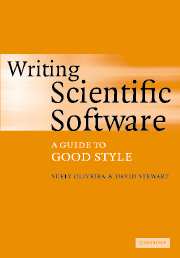Book contents
- Frontmatter
- Contents
- Preface
- Part I Numerical Software
- Part II Developing Software
- 6 Basics of computer organization
- 7 Software design
- 8 Data structures
- 9 Design for testing and debugging
- 10 Exercises
- Part III Efficiency in Time, Efficiency in Memory
- Part IV Tools
- Part V Design Examples
- Appendix A Review of vectors and matrices
- Appendix B Trademarks
- References
- Index
7 - Software design
Published online by Cambridge University Press: 28 January 2010
- Frontmatter
- Contents
- Preface
- Part I Numerical Software
- Part II Developing Software
- 6 Basics of computer organization
- 7 Software design
- 8 Data structures
- 9 Design for testing and debugging
- 10 Exercises
- Part III Efficiency in Time, Efficiency in Memory
- Part IV Tools
- Part V Design Examples
- Appendix A Review of vectors and matrices
- Appendix B Trademarks
- References
- Index
Summary
Software engineering
Software engineering is about the task of designing and implementing software. It is not about the specific algorithms or techniques to be programmed, but about how to organize both the software and the people who develop it. While many programmers have the attitude “Just do it!” and can cope with small programs just fine, large programs and, indeed, any programs that you expect other people to use, need careful attention and design.
There are many other books available to help programmers be more effective at their work. One of the first such books is The Mythical Man-Month [17], which is justifiably famous for its advice on avoiding software disasters. A book that many have found invaluable is Elements of Programming Style [65]. Recent books of this kind include books on trends such as Extreme Programming like [21], and The Pragmatic Programmer [58]. Many contain a great deal of wisdom, and have been written with considerable and deep experience. They usually generate a great deal of lively controversy. One of the especially good features of these books, as opposed to textbooks on software engineering such as [86], is their emphasis on practical aspects of programming and the words of experience with large systems and difficult situations.
Software life-cycle
Software is eternal. Once a program is written in a specific programming language, it is a valid program in that language and when compiled and executed will do essentially the same thing now and forever. Yet our software is ever-changing. Microsoft comes out with new versions of its operating system every few years, and sends out patches on a weekly basis.
- Type
- Chapter
- Information
- Writing Scientific SoftwareA Guide to Good Style, pp. 57 - 89Publisher: Cambridge University PressPrint publication year: 2006

